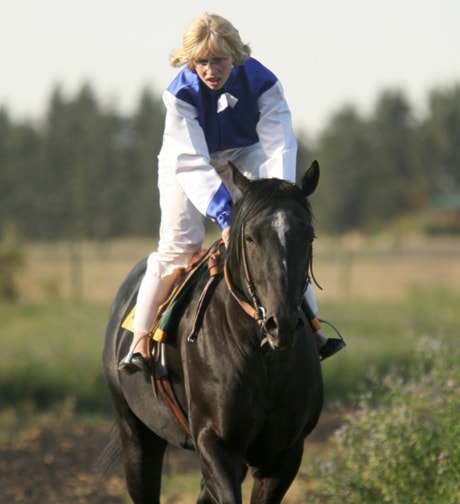OLDS — There’s rock-hard proof that Teagan Oulton, now 20, set her sights early on riding racehorses.
Earlier this year, Oulton put another notch in her stirrup irons during the American Quarter Horse Association’s Challenge series at Evergreen Park in Grande Prairie. Her first-place win on Hawk’s Halo qualified the filly for a high-money stakes race in California.
Back in the living room at her family home, just north of Olds, Oulton’s parents, Wes and Sue, recall a little exercise from Grade 4, when the teacher had each of the students write a letter to be opened when they graduated from high school.
Typical of Teagan, her letter was short and to the point.
“One day, I hope I’ll be a jockey.”
Admittedly, the opportunities to follow her dream were a little better than average, considering that Teagan grew up on a farm that is focussed on quarter-horse racing.
There are also issues of size, courage and capability.
She and her younger siblings, Lexya, Tyrel and Riordan all play a hand in helping with the racing program Wes started in 1976, in partnership at the time with Cliff Whitelock.
Of the four children, Teagan will be the only jockey, say Wes and Sue. Eighteen-year-old Lexya has the capability and the interest, but she’s taller and heavier.
The boys, aged 17 and 15, are good with the horses, but they’re already too big to be jockeys and neither one is interested in the job.
Even with so many cards stacked in Teagan’s favour, breaking into the jockey’s room wasn’t easy. Wes feels the racing industry was biased against his daughter on two fronts: her gender and the fact that she came from the quarter-horse sector and not the thoroughbreds.
It’s a bias that he doesn’t believe the industry can afford, given that there is such a shortage of jockeys, inexperienced riders are being brought in from other countries, including Jamaica and Barbados.
As all the other obstacles facing Teagan were being cleared, even the weighted saddle pad she uses to meet weight limits fell under scrutiny, says Wes.
Horse Racing Alberta finally relented and Teagan was allowed to take her first mounts in 2008.
She rode 189 races altogether that year, including both thoroughbreds and quarter-horses.
She hit the front of the pack enough times to be named Alberta Community Thoroughbred Racing Association’s Apprentice Jockey of the Year, earning 18 wins, 32 places (second place) and 19 shows (third place) in 137 races.
But it wasn’t until July 18 of this year, riding the filly Mademoizilla at Evergreen Park, that Teagan finally managed to bring one of her father’s horses to the front of the pack.
As proud as Wes and Sue are of their daughter’s accomplishments to date, it comes at a price.
There is no question that riding race horses is the most dangerous job in the world, says Teagan.
A running quarter-horse is a rocket with a coat of hair. According to the American Quarter Horse Association, top-rated racing quarter-horses hit a peak speed of 90 kilometres per hour about 200 metres into a 400-metre sprint.
For the riders, it’s not a question of whether there will be a wreck, but when and how bad.
After two near misses in each of the two previous weekends, Teagan got her first taste of the turf earlier this season when a horse fell in front of her, bringing her mount down.
She rolled under the rail, avoiding being trampled by oncoming horses.
That’s when everybody found out where the Oultons get their speed, says Wes.
Sue, who had been watching from the stands, made it to trackside in a heartbeat.
Wes had been in the barn, working with another horse. He didn’t even know anything had happened until people started coming up to tell him, “Don’t worry. She’s OK.”
It’s a risk Teagan and her parents take in stride, just part of the excitement in weekend job that is providing her with enough money to pay for her university education, buy her a car and leave her with cash in the bank when she graduates.
Teagan is currently enrolled in an electrical engineering program at the University of Alberta. Whether she will actually pursue a career in engineering is still up in the air.
She wants to apply for a spot on the prestigious Darley Flying Start thoroughbred racing school, which admits only 12 students per year worldwide. Having a completed university degree is just one of the prerequisites for admission to the school, founded 2003 by Sheikh Mohammed bin Rashid Al Maktoum of Dubai.
Whether or not she gets in, Teagan plans to ride in the races for as long as she possibly can.
bkossowan@www.reddeeradvocate.com
